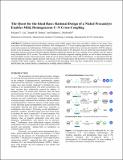The Quest for the Ideal Base: Rational Design of a Nickel Precatalyst Enables Mild, Homogeneous C–N Cross-Coupling
Author(s)
Liu, Richard; Dennis, Joseph M.; Buchwald, Stephen Leffler
DownloadSubmitted version (4.260Mb)
Open Access Policy
Open Access Policy
Creative Commons Attribution-Noncommercial-Share Alike
Terms of use
Metadata
Show full item recordAbstract
© 2020 American Chemical Society. Palladium-catalyzed amination reactions using soluble organic bases have provided a solution to the many issues associated with heterogeneous reaction conditions. Still, homogeneous C-N cross-coupling approaches cannot yet employ bases as weak and economical as trialkylamines. Furthermore, organic base-mediated methods have not been developed for Ni(0/II) catalysis, despite some advantages of such systems over those employing Pd-based catalysts. We designed a new air-stable and easily prepared Ni(II) precatalyst bearing an electron-deficient bidentate phosphine ligand that enables the cross-coupling of aryl triflates with aryl amines using triethylamine (TEA) as base. The method is tolerant of sterically congested coupling partners, as well as those bearing base- and nucleophile-sensitive functional groups. With the aid of density functional theory (DFT) calculations, we determined that the electron-deficient auxiliary ligands decrease both the pKa of the Ni-bound amine and the barrier to reductive elimination from the resultant Ni(II)-amido complex. Moreover, we determined that the preclusion of Lewis acid-base complexation between the Ni catalyst and the base, due to steric factors, is important for avoiding catalyst inhibition.
Date issued
2020Department
Massachusetts Institute of Technology. Department of ChemistryJournal
Journal of the American Chemical Society
Publisher
American Chemical Society (ACS)